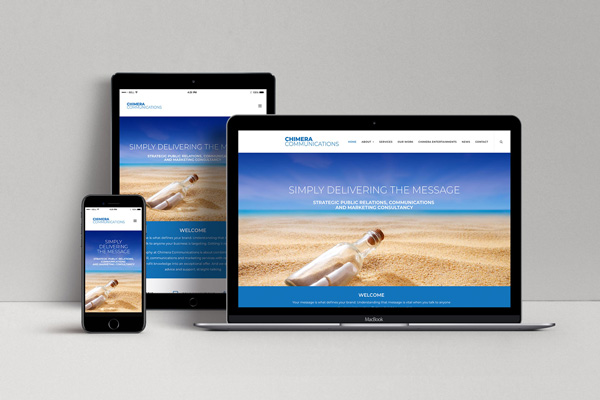Marketing your business – 5 things to do now
Marketing your business – 5 things to do now
With the current Coronavirus situation giving cause for concern about the lack of business trading, it goes without saying that many people are wondering what to do for their marketing.
We have had to change the way we are marketing and the voice and message of it to adapt for the changing times. Invariably with a glut of advice telling what to do it has become overwhelming and causes businesses to hesitate with their marketing. History tells us that in times of recession it's not the time to stop your marketing, rather to increase it.
So with this in mind, we took a step back to look at our own marketing realised that the basic fundamentals needed some attention. Without these building blocks in place you run the risk of any marketing activities, drives and campaigns being ineffective. Here are 5 things you can do now to improve those foundations on which to build your marketing further.
1 – Social Media
Now is a good time to look at your social media profiles and update them to ensure that they work well for you.
You probably already know that social media marketing is important for all businesses. But, simply having accounts isn’t enough. It’s important to align your profile to your ideal clients.
First, keep your account information updated and accurate. If something about your business changes, your social media profile should change, too. Make sure your website, address, hours, logo and photos are all current. Ensure your branding is up to date and consistent. Make sure you describe what you do and who you do it for clearly and accurately.
Second, post fresh content. You must regularly post new content on your social media pages. Don’t create an account and then forget about it. Frequent posts keep you in front of customers’ faces. Post about new products and services, events, industry insights and news and show your followers what you and your business are up to.
Remember to check all your social media channels; LinkedIn, Twitter, Facebook, Instagram, Google My Business, YouTude etc. It’s a good time to also check any listings you have with Chamber of Commerce directories or any other business directories.
2 – Website development
We’ve all had it in mind to revisit our websites and look at what we have written and the services we provide. It’s always good to make sure that you have included any new services or changes to existing ones. It’s equally important to consider whether the content you include is clear, accurate and compelling. Does it speak to you in a matter of fact way or does it speak to you in a personable and friendly way? This can make a big difference to conveying your brand values and encouraging engagement with visitors to your website.
It’s important to understand your value proposition. It’s the reason for existing, the reason to be chosen over your competitors and the promise of value that will be delivered to your customer'.
Why is value proposition important? – If you are unable to communicate your value to your customers, why should customers place value in what you offer? If you are unable to tell customers why they should choose you and why they should pay what you are asking, why would they?
Branding – Is your website up to date and consistent with your branding, is your logo up to date, are you using the same colours and fonts across all your marketing, does the imagery help convey your messaging? If not is might be time for a visual refresh.
Is your website easy to use and navigate and what is the user experience (UX) when they arrive at your website. Can they find what they want, is it easy to get to the relevant pages or is it buried within the website? Do you use a Call To Action (CTA) on pages and posts? Visitors need prompts on the next step to take once they have found what they are looking for.
SEO – Are you being found for what you provide? The content of your website plays an important part in making it SEO-friendly which leads to a better UX. So if you want to be found for specific services or products think about the questions people ask when searching online. Try and build these into the content and think about how you answer their questions. Check whether you are using the perfects keywords, meta tags and descriptions.
Links – Now that you’ve reviewed your content, branding and SEO, there is one thing that many forget to check. Are all the links working on your website? It’s always surprising how many links are incorrectly adding and not checked, or perhaps the link is old and no longer available. It’s work running your website domain name through an online link checker. There are many free broken link checkers, such as Dead Link Checker, that you can use.
Remember, if you are unsure how to implement changes on your website contact your website developer or provider, they should be able to help you. Alternatively, contact us if you don’t have a web developer.
3 – Get testimonials
Your clients are valuable to you in many ways, not least of all in the testimonials for your good work. Before people buy something, they often look for reviews that validate their purchase. People want to know that they’re spending money on quality. And, they want to know if what you have to offer is better than what your competitors have to offer.
Remember as well as using testimonials on your website you can ask clients to submit them to LinkedIn, Facebook, Goggle My Business etc., and that’s good for being found through SEO too.
4 – Research more
Research what your audience wants, and what your industry needs. Research what people are looking for, and create the answers to the questions that they have.
Research is what will make a difference. Research what other people in your industry are doing. Do it better or differently. Use Google, Twitter, LinkedIn or Facebook. Look for what people are talking about and create better content around that.
5 – Get blogging and posting!
You’ve done your research and have ideas about what customers need or want and why you have the answer. So become an expert – you can improve your business marketing by positioning yourself as an expert. Becoming an expert is one of the long-term marketing tactics for small business, but can provide great results.
Link back to your website and think about the customer journey from that first point of contact, whatever it might be, to that point at which you are actually speaking to them. Use visuals too, they are invaluable in gaining attention top you blogs and posts.
Remember to engage with people and businesses. Join in the conversations, ask questions on other people’s posts. It’s just as important as posting your own content in raising your profile and building relationships.
Where do I start with my marketing? Which building blocks do I start with?
Start with one thing that you know you need to do, and do it well. Sucking eggs comes to mind when I say that, but we are as guilty of trying to do everything at once as anyone. It pays to do things logically and methodically in a manageable way, the feel good factor of ticking it off that list is what will spur you onto completing the next task or goal.
So, what’s next when this is all in place…
You’ve diligently taken the time to ensure the basic elements of your marketing channels are up to date, accurate and compelling. Now it’s time to make a strategy and plan to reach those potential clients through the use of your brand proposition, values and messaging in tailored campaigns.
If you are unsure what to what to do next, we'd love to hear from you. Contact us for a free consultation and chat about your marketing your business.
How to choose a business name

How to choose a business name
One of the best things about starting your own business is being able to choose a name for yourself. But it’s not as straightforward as you might think. It’s something you have to get right, not just for legal reasons but for creating the right impression.
This article will show you how to choose the right name and what you’ll have to do to ensure you’re following the official rules, that’s whether you’re becoming a sole trader or limited company…
Giving the right impression
When choosing a company name, keep in mind that it will act as a first impression of your business. You want your name to convey the right feeling and message. That’s whether you’re trying to get across professionalism or something fun and different. It should also work across all mediums including your website, marketing and signage.
Consider pronunciation and spelling
Just consider how many times you’ll have to give your details out over the phone! Now think about your potential business name. Is it easy to pronounce? Will people understand what you’re saying? And is it easy to spell? Try to pick something that’s easy to say and write.
Reflect what you do
If appropriate, consider a name that reflects what you do. This will get across very quickly what your business is about to potential customers. It might also help in terms of Search Engine Optimisation (SEO) where you can benefit from having a keyword or two in your name. But only do this if your business isn’t likely to change and offer different services in future.
Think about the future
Always keep the future in mind when choosing a name for your business. Are you likely to expand? Will you be providing additional services in future? Choose a name that can easily see you through the next 10 years. Don’t pick something that’s going to narrow your growth. You also have to choose something that won’t date easily, so avoid words and phrases that could easily go out of fashion.
Trading and corporate names
Did you know you can choose an official ‘corporate name’ but you can choose a ‘trading name’ to represent that corporate name? This means you can choose something quite corporate for your actual official name but create a trading name that’s creative, or shorter and sweeter. You just have to make sure you highlight your trading name/corporate name on all marketing materials, including your website.
Consider potential overseas hurdles
Are you going to be trading overseas? If so, check that your business name doesn’t mean anything offensive in any other language. You don’t want to limit yourself before you’ve even started, so double check meanings in other languages.
Check availability
So you’ve got a few ideas knocking around – the next important step is checking availability of your name ideas. Go on to the Companies House Web Checker to see if anyone else has already beaten you to it. And if you’re home-free, go on something like 1&1 Ionos to check that relevant domain names are also up for grabs. When purchasing domain names, it’s wise to buy something that not only has the ‘co.uk’ available but the ‘.com’ as well.
Names for sole traders
If you choose to become a sole trader, you’re allowed to operate your business under your own name but you can choose anything you like. However, there are some legal aspects to remember:
- Your business name must not be offensive;
- include any of the terms for public limited company (PLC) or limited (LTD) or LLP or their Welsh equivalents
- or contain any sensitive words or expressions (i.e. there are certain words/expressions you’re not allowed to use unless you have official permission, for example ‘British’ and ‘Authority’).
Next, check that no one else is using your proposed business name. Bear in mind, that if a sole trader at the other end of the UK has the same name, there might not be an issue. But you could run into trouble if another local firm is using it. In which case, you should choose a different name. How do you check to see if someone’s already got your name? Look through phone books, use Google or simply use the most excellent Companies House Web Checker.
Things to consider for limited companies
If you’re forming a limited company you must register your name and any other relevant details with Companies House. Bear in mind, it’s essential your proposed name does not breach any rules on name endings, ‘same as’ rules or include a prescribed or sensitive work without prior permission. Here’s the rules so you don’t get stuck. You must ensure that:
- Your name ends with ‘limited’ or Ltd
- Your name isn’t offensive
- Your name isn’t the same as anyone else in the index of company names (which you can check via the Companies House website)
- Your name doesn’t include anything sensitive in terms of words or expressions… unless you’ve had official permission to use them.
Double check trademarks
Another important point is trademarks. You have to make sure your proposed business name isn’t the same or very similar to a registered trademark. Use this handy Company Name and Trademark Checker.
Displaying your business name
Did you know that every business must display its name and relevant details to show customers who they’re dealing with? If you’re a limited company, you have to display your registered name on all hard copy and digital correspondence and documents. This includes: letters, notices, emails, bills of exchange, invoices and even your website.
But what information must a limited company display? You must show:
- the place of registration and your registered business address
- the registered business number
- whether it’s a limited company.
Please note, you’ll also have to display your VAT registration number on your business website.
For sole traders, you must display your business name, your own name and your business address in all areas, i.e. across all stationery, correspondence and your own website.
And that’s how you choose a business name. You’ll need to do this before anything else because if you’re opening a business account, they’ll want to see a letterhead with your business name and logo printed on it. Plus if you’re informing the Inland Revenue of your new business, they’ll need to know as well.






